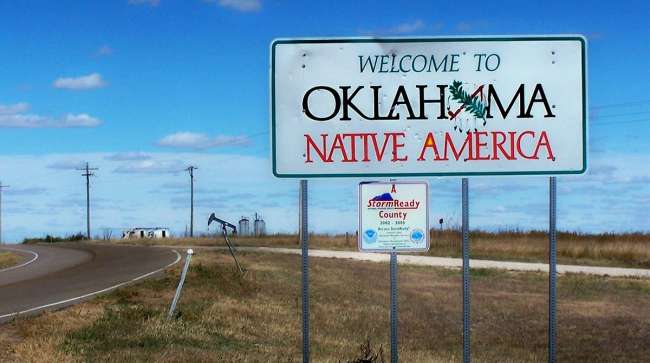Oklahoma Fuel Taxes Among Lowest in the Nation

Oklahomans pay for more at the pump than just gas.
While gasoline prices are hovering around $2 per gallon in Oklahoma, that’s not the direct cost of the fuel. State and federal taxes tally up to 35.4 cents of total gasoline cost per gallon.
The federal excise tax on gasoline is 18.4 cents per gallon across the nation, but states set their own tax rates. Oklahoma has the second lowest gasoline and diesel taxes in the nation at 17 cents on gasoline and 14 cents on diesel. Only Alaska has a lower fuel tax.
Motor fuel taxes, along with other vehicle-related costs, pay for road and bridge construction and maintenance throughout the state, and tax experts say tying a tax to a direct benefit is good tax policy.
“We’ve historically used gasoline tax to have users pay for road service,” said Scott Drenkard, state projects director with the Tax Foundation, an independent tax policy nonprofit. “The goal is not to be perfect in a user tax but to move in the direction that has the road user paying for their provision.”
Drenkard said most state fuel taxes are not tied to inflation, however, and may fall short of providing enough funding to support transportation needs.
Highway construction and maintenance in Oklahoma is funded by a combination of motor fuel tax, motor vehicle tax and fees and state income taxes. By law, toll collections go to the Oklahoma Turnpike Authority for turnpike construction and maintenance, according to the Oklahoma Department of Transportation.
Raising motor fuel tax was discussed during the last legislative session but did not move forward.
ODOT Executive Director Mike Patterson said raising the fuel tax wouldn’t have increased revenue for ODOT, because state lawmakers wanted to eliminate the department’s revenue from income tax, channeling that money elsewhere.
Meanwhile, lawmakers have raided road funding including fuel tax and the county improvements for roads and bridges revolving fund in an attempt to fill budget holes. While channeling income tax elsewhere and increasing fuel tax might be good tax policy from an economic perspective, at least one Cleveland County commissioner thinks raising the fuel tax is a bad idea.
“My first concern is we already have dedicated funds going to our roads, and yet the legislature has decided to take our funds and use it for their own purposes,” County Commission Darry Stacy said. “What would be their guarantee that they wouldn’t take that [fuel tax] money?”
Stacy believes there are ways the state might reduce spending without cutting core services.
“It’s always easier to look for new revenue streams rather than taking a hard look at what we’re spending,” he said. “From the outside looking in, I don’t think we’ve got the state completely in order. Any government, whether it be county or state, you have to determine what your priorities are to determine your spending.”
Last year, the state diverted $50 million from the fuel tax revenue to the state’s general fund.
For Fiscal Year 2017 ending June 30, motor fuel taxes were expected to net $445 million for the state. Of that money, $33 million was designated for transportation-related, non-highway uses.
“The passenger rail fund gets a small part of that, and the transit revolving fund [which helps OU’s transit program] gets some,” Patterson said. “It also includes money that’s collected in the sale of aviation fuel, and it helps airports.”
Indian tribes get a 4.5% — $20 million — slice of the fuel tax pie as part of an agreement that requires tribal fueling stations to collect and remit state fuel taxes, rather than keeping all of the taxes or charging a lower rate of tax in competition with non-tribal fueling stations.
Counties and municipalities also get a share of the fuel tax pie. But while that money is a direct allocation, it must be used for road and bridge projects. Counties were projected to receive nearly 30% — $131.9 million — while cities and towns were estimated to receive $5.4 million.
A sliver of the fuel tax — 0.3%, or $1.5 million — is designated for the state’s general fund.
The $50 million diversion from ODOT’s share of the fuel tax allocation equaled an estimated 24.5% reduction to the state transportation fund.
“This trend started about 2014 when the legislature got into asking the department to help balance the budget and reallocating ODOT’s money and the money from county roads and bridges to other state departments,” Patterson said. “The certified amount of sales tax that was supposed to come to the agency for 2017 was approximately $205 million. That’s when the legislature decided to take $50 million of that and reallocate it to general revenue.”
Patterson said the cigarette tax being struck down by the state Supreme Court and other challenges to budget-balancing measures may mean another deep cut this year, as well.
“Statutorily, we — the Department of Transportation — should receive about 48% of the allocation of motor fuel tax which includes diesel, gasoline and CNG,” Patterson said. “This is not the only money that Department contributed to balancing the budget in 2017.”
On Dec. 1, there was a transfer out of ODOT’s cash balance of $20 million. When the state Senate proposed even greater cuts, there was a threat of the department not being able to meet current obligations due to lack of cash flow.
“We weathered that cash flow situation for the time being, but we’re rebalancing the eight-year plan,” Patterson said. “We may have to break some projects out of the eight-year plan that we’ve already told people we would do, but we won’t know that for six weeks.”
Distributed by Tribune Content Agency, LLC




